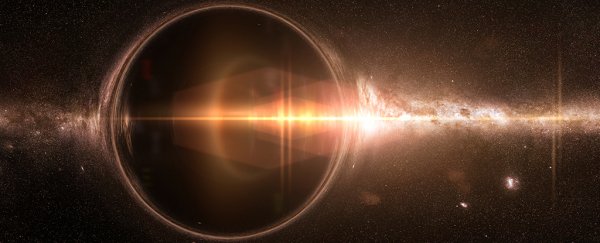A study on dozens of galaxies within several billion light years of our own has revealed black holes that far exceed our expectations on just how big these monsters can grow.
The discovery not only helps us better understand the evolution of our Universe's building blocks, it leaves us with a new intriguing question – just how do black holes like these get to be so incredibly massive?
By now, the collapsed cores of massive stars known as black holes need no introduction. We've heard about their cosmic crashes rippling space-time, watched them belch, and expect to capture the closest look yet at their nature very soon.
It seems like we can't enough of these things, and there's a good reason why.
"Galaxies are the building blocks of our Universe, and to understand their formation and evolution, we must first understand these black holes," says physicist Julie Hlavacek-Larrondo from the Université de Montréal in Canada.
Not that the black holes make this job easy, so to get around the tricky problem of studying something that likes to keep its secrets tucked away inside an impenetrable void, astrophysicists look for shortcuts.
One is to find a relationship between a black hole's mass and the galaxy surrounding it. If there was an easy way to match a galaxy's size with the black hole at its core, it would save a lot of hassle.
So Hlavacek-Larrondo teamed up with other researchers from Canada, Spain, and the UK to study 72 galaxies within a radius of 3.5 billion light years to see if they could nail down some kind of formula in estimating the mass of the black hole at their centre.
To estimate the size of the black holes themselves, they analysed the spectrum of X-rays being spat out by the whirling disc of heated gas being sucked into their crazy gravity wells.
The researchers then correlated this figure with the overall luminosity of the surrounding galaxy.
It makes sense that the bigger the galaxy, the bigger the black hole – but this relationship isn't quite as simple as they'd thought.
"We have discovered black holes that are far larger and way more massive than anticipated," says the study's lead author Mar Mezcua from the Institute of Space Sciences in Spain.
Rather than growing in tandem, the masses of a number of the black holes far outstripped expectations, growing faster than other stars in their neighbourhood.
In fact, around 40 percent of them weighed the equivalent of 10 billion times the mass our Sun or more.
They don't come much bigger; the current record-holder comes in at around 17 billion Suns, though other studies hint at a 40 billion solar mass behemoth so far away its light travels 12.1 billion years to reach us.
Either way, these babies are huge. The question is now – why?
The researchers have proposed two hypotheses; either they started big and then pulled a galaxy around them, or we're missing something in our current knowledge about how galaxies produce black holes.
"Are they so big because they had a head start or because certain ideal conditions allowed them to grow more rapidly over billions of years?" says Mezcua.
"For the moment, there is no way for us to know."
A separate study available on the pre- peer review website arxiv.org might help provide an answer.
Looking at more than 30,000 galaxies up to 12.2 billion light years away, researchers discovered that the ratio between the growth of a black hole and the growth rate of stars went up as the size of their surrounding galaxy increased.
Galaxies with more stars seem to have greedier black holes, in other words.
The relationship between star formation and black holes is clearly a complicated one. But one thing is becoming certain – our Universe wouldn't be the same without these monsters.
This research was published in the Monthly Notices of the Royal Astronomical Society.
